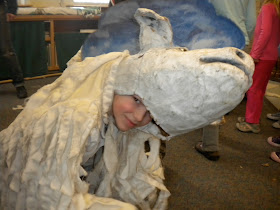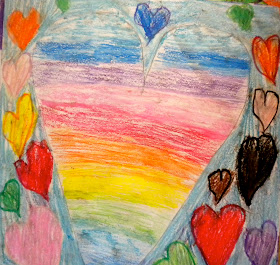For our Artist-in-Residence this year, Waitsfield School is pleased to welcome four artists from Bread and Puppet Theater from Glover, Vermont. Ali, Katherine, Lili and Susie are part of a group of artists and performers who work collaboratively to create performances that respond to local concerns and the political climate of the times. They use paper mache and other recycled materials to make puppets and "cheap art" to use in the shows.
From the Bread and Puppet website:
"Cheap Art hopes to reestablish the appreciation of artistic creation by making it available to a wider audience and inspire anyone to revel in an art making process that is not subject to academic approval or curatorial acceptance."
Waitsfield students have created a performance in response to their variety of experiences during the Huricane Irene flood. All grades are involved in different aspects of the process, which integrates art, music, writing, movement and storytelling.
This is the blog for the Waitsfield Elementary School Art Program in Waitsfield Vermont. This site is maintained by Nora McDonough. It contains photographs and information about past and current art projects completed at all levels, K-6.
Pages
▼
Monday, February 20, 2012
Tuesday, February 14, 2012
Jim Dine Hearts
Third and fourth grade artists used oil pastels to draw hearts inspired by pop artist Jim Dine.
Happy Valentine's Day!
Examples of Jim Dine's hearts:
Heart artwork by student artists:
Friday, February 10, 2012
10 Lessons that Art Teaches
Written by Elliot Eisner, an ardent arts advocate, I originally found this from the April 2011 issue of Arts & Activities magazine. It's a short, succinct argument for the importance of art in education. Here it is:
1. The arts teach children to make good judgments about qualitative relationships.Unlike much of the curriculum in which correct answers and rules prevail, in the arts, it
is judgment rather than rules that prevail.
2. The arts teach children that problems can have more than one solutionand that questions can have more than one answer.
3. The arts celebrate multiple perspectives.One of their large lessons is that there are many ways to see and interpret the world.
4. The arts teach children that in complex forms of problem solving
purposes are seldom fixed, but change with circumstance and opportunity. Learning in the arts requires the ability and a willingness to surrender to the unanticipated possibilities of the work as it unfolds.
5. The arts make vivid the fact that neither words in their literal form nor numbers exhaust what we can know. The limits of our language do not define the limits of our cognition.
6. The arts teach students that small differences can have large effects.The arts traffic in subtleties.
7. The arts teach students to think through and within a material.All art forms employ some means through which images become real.
8. The arts help children learn to say what cannot be said.When children are invited to disclose what a work of art helps them feel, they must reach into their poetic capacities to find the words that will do the job.
9. The arts enable us to have experience we can have from no other source and through such experience to discover the range and variety of what we are capable of feeling.
10. The arts' position in the school curriculum symbolizes to the young
what adults believe is important.
1. The arts teach children to make good judgments about qualitative relationships.Unlike much of the curriculum in which correct answers and rules prevail, in the arts, it
is judgment rather than rules that prevail.
2. The arts teach children that problems can have more than one solutionand that questions can have more than one answer.
3. The arts celebrate multiple perspectives.One of their large lessons is that there are many ways to see and interpret the world.
4. The arts teach children that in complex forms of problem solving
purposes are seldom fixed, but change with circumstance and opportunity. Learning in the arts requires the ability and a willingness to surrender to the unanticipated possibilities of the work as it unfolds.
5. The arts make vivid the fact that neither words in their literal form nor numbers exhaust what we can know. The limits of our language do not define the limits of our cognition.
6. The arts teach students that small differences can have large effects.The arts traffic in subtleties.
7. The arts teach students to think through and within a material.All art forms employ some means through which images become real.
8. The arts help children learn to say what cannot be said.When children are invited to disclose what a work of art helps them feel, they must reach into their poetic capacities to find the words that will do the job.
9. The arts enable us to have experience we can have from no other source and through such experience to discover the range and variety of what we are capable of feeling.
10. The arts' position in the school curriculum symbolizes to the young
what adults believe is important.



























































